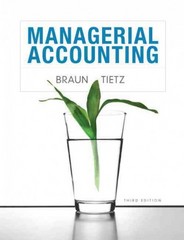Question
1.1. Which of the following represents all the elements of the financial statements? A. Assets, equity, and liabilities. B. Assets, liabilities, equity and statement of
1.1. Which of the following represents all the elements of the financial statements?
A. Assets, equity, and liabilities.
B. Assets, liabilities, equity and statement of comprehensive income.
C. Notes, Equity, Drawings, income and expenses.
D. Asset, liabilities, equity, income and expenses.
1.2 Which one of the following comprises a full set of financial statement?:
A. Statement of profit or loss and other comprehensive income, statement of
financial position, statement of changes in equity, statement of cash flows,
and notes to the financial statements.
B. Statement of financial position, statement of profit or loss and other
comprehensive income, and a statement of changes in equity.
C. Statement of comprehensive income and statement of financial position.
D. Statement of profit or loss and other comprehensive income, statement of
financial position, statement of changes in equity and statement of cash flows.
1.3 Which one of the following recognises the idea that assets and income should
not be overstated while liabilities and expenses should not be understated? :
A. Matching principle,
B. Accrual concept,
C. Principle of prudence.
D. Consistency concept.
1.4 The consistency concept requires that;
A. Items that have been combined in the current financial period do not have to
be combined in the same way in the next financial period.
B. Some items are treated in the same way within an accounting period.
C. Every single item in the statement of financial position only must be treated in
the same way.
D. All similar items are treated in the same way within an accounting period as
well as from one year to the next year.
1.5 "Past financial performance" and "present financial position" refer to:
A. Statement of profit or loss and other comprehensive income and the
statement of financial position respectively.
B. Statement of financial position and the statement of profit or loss and other
comprehensive income respectively.
C. Statement of profit or loss and other comprehensive income and the
statement of changes in equity.
D. Statement of profit or loss and other comprehensive income and the
statement of cash flows.
1.6 In terms of international financial reporting standards, offsetting is allowed when:
A. The items being offset are material.
B. One of the items is not required or not allowed by the international financial
reporting standards.
C. The amounts being offset arise from transactions that are not similar in
nature.
D. It required by a statement of international financial reporting standard in
accounting or when one of the items being offset is not material.
1.7 Which one of the following best helps users of the financial statements when they
need to compare information on the financial statements of the same entity
and/or the financial statement of different entities?
A. Matching principle.
B. Accrual concept.
C. Consistency principle.
D. Prepaid concept
1.8 The principle that any personal transactions undertaken by the owner of a
business entity must be kept separate from that business entity is known as:
A. Principle of duality.
B. Entity concept.
C. Consistency principle
D. Accrual concept.
1.9 Complete the following sentence. The purpose of the statement of changes in
equity is to;
A. Express the financial position at a given point in time.
B. Reconcile the net worth of an entity at the beginning of the year to the net
worth at the end of the year.
C. Measure the performance of the entity by determining the profit or loss for the
period.
D. Measure the ability of an entity to generate, manage and use cash efficiently.
1.10 A statement of financial position is a financial report that determines and shows
the :
A. Financial position of an entity during an accounting period.
B. Operating performance of an entity during an accounting period.
C. Financial position of an entity at a specific point in time.
D. Operating performance of an entity at a specific point in time.
Step by Step Solution
There are 3 Steps involved in it
Step: 1

Get Instant Access to Expert-Tailored Solutions
See step-by-step solutions with expert insights and AI powered tools for academic success
Step: 2

Step: 3

Ace Your Homework with AI
Get the answers you need in no time with our AI-driven, step-by-step assistance
Get Started


